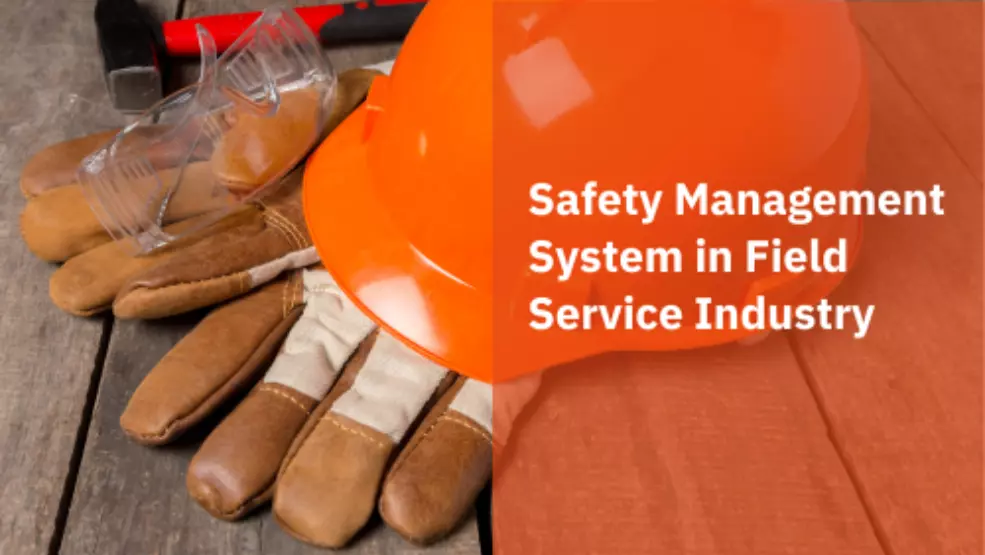Are you considering implementing a safety management program for your company’s field service operations? If not, you should really give it serious thought. Your technicians are the face of your business, representing your brand to customers. The more you prioritize their safety and well-being as employees, the more satisfied and motivated they will be in their roles. You wouldn’t want your technicians injured by machinery mishaps, or your work halted due to vehicle breakdowns.
So, implementing a safety management system is a must, and it comes with the added advantage of tax benefits. But what exactly does a safety management system mean? Well, the key components of a safety management system are:
- Safety policy
- Safety management
- Safety assurance
- Safety promotion
Read along to learn in detail about implementing a safety management system in field service. To give a short recap, we will discuss the benefits of having contract management software, augmented reality, personal protective equipment, and tax deductions you can access.
Tax credits for safety management
We know you were excited about this part of the information. Who isn’t happy about tax credits? The happy news is you can write off expenses on safety equipment and safety software under Section 179 of the Internal Revenue Service, Section 179 of the Internal Revenue Service, United States. So, you need not have second thoughts about buying personal protective gear and field service management software. Just so you should know, for the tax year 2023, the maximum limit for tax deduction under Section 179 is $ 1,160,000.
Safety + Efficiency = Field Service Management Software. Start Free Trial Now
A 5-step approach for effective safety management
A strong safety management system begins by establishing clear safety policies and guidelines. These policies should be tailored to align with your business’s safety goals. Once in place, you need to diligently manage these policies through ongoing risk assessments and ensure their consistent integration into your day-to-day operations. The next step is assurance which involves regular inspections and audits. Afterward, it is all about promoting safety through comprehensive training and effective communication.
1. Following government safety policies
To ensure your safety management system aligns with industry standards and regulations, it is crucial to follow government safety guidelines while also developing your own policies based on your specific field service needs. The United States government has designated various industry-specific bodies to oversee safety standards, such as:
Construction Industry: The Occupational Safety and Health Administration (OSHA)
Pest Control Industry: The National Pest Management Association (NPMA)
Furniture Industry: The International Furnishings and Design Association (IFDA)
Roofing Industry: The National Roofing Contractors Association (NRCA
HVAC Industry: The Air Conditioning Contractors of America (ACCA)
Mining Industry: The Mine Safety and Health Administration (MSHA)
Waste Management: The Environmental Protection Agency (EPA)
For instance, OSHA places strict emphasis on the use of Personal Protection Equipment (PPE) in the construction industry. Meanwhile, the National Pest Management Association (NPMA) mandates the use of less harmful chemicals in pest control, along with comprehensive documentation of pesticides and chemicals used in jobs. Your journey to ensuring the safety of your business begins with compliance with these industry-leading safety guidelines.
2. Setting up your own safety guidelines
Apart from the government safety guidelines, you should set up some safety rules with respect to your business operations. Note that the guidelines you set should encompass critical areas such as
- Employee health and wellness (Download checklist)
- Machine safety (Download checklist)
- Warehouse safety (Download checklist)
- Vehicle safety (Download checklist)
Why? Accidents involving vehicles, machinery, and warehouse operations are primary sources of employee injuries. Ensuring safety protocols in these areas can significantly reduce the risk of accidents and create a safer work environment.
3. Use personal protection gear at all costs
According to the OSHA Act, employers must provide a safe workplace by furnishing workers with appropriate protective gear. Failure to do so grants employees the right to file complaints and even refuse to work in hazardous conditions. Protective gear requirements may vary by industry but should typically include eye and face protection gear like goggles and gloves, fall protection gear such as hard hats and sturdy shoes, and respiratory protection gear like respirators and masks.
4. Conduct safety assessment through field service management software
Safety assessment is pivotal in maintaining a secure work environment. Yet, keeping track of safety policies and monitoring your workforce can be overwhelming if you rely solely on manual methods. In the ever-evolving landscape of safety management, FSM software emerges as an indispensable tool. It helps in record keeping, accountability, and hazard analysis.
1. Effortlessly create employee profiles and assign teams
Consider this scenario: Imagine being able to seamlessly consolidate all employee records into one system. Field service management software empowers you to achieve just that. You can effortlessly create teams and categorize employees based on their roles and responsibilities, ensuring that safety management is as organized as it is effective.
2. Create custom safety checklists
One standout feature of FSM software is its ability to customize checklists to meet your unique safety requirements. Think of it as creating a tailored safety checklist that is completely documented within the software, ensuring that nothing falls through the cracks. But safety management doesn’t stop with people; it extends to assets as well.
3. Monitor and risk analysis through asset management
From vehicles to machinery and warehouses, the asset management software facilitates tracking and conducts regular inspections. With a complete work order history at your fingertips, monitoring the health of your assets becomes a hassle-free endeavor. This means that a significant portion of your safety concerns can be addressed preemptively.
Asset management plays a pivotal role in promoting safety by:
- Maximizing uptime with runtime-based preventive maintenance to ensure that your assets are in peak condition when you need them most.
- By reducing unnecessary downtime due to sudden breakdowns, the software not only safeguards your workforce but also enhances operational efficiency.
- Setting up servicing alerts and reminders ensures that your assets receive the attention they need precisely when they need it.
- Real-time data synchronization with your back-office systems ensures that you have the most up-to-date information at your disposal, fostering agility and informed decision-making.
4. Streamline organization and record-keeping with contract management
Now, let’s clear up a common misconception: Contract management software is not limited to managing relationships with customers, vendors, or suppliers. It is a versatile tool that extends its capabilities to include your employees. It is instrumental in creating and managing service-level agreements, policies, and regulations with your employees.
Contract management software streamlines tasks, enabling data-driven automation that simplifies routine activities. Picture this: Every detail of a contract, policy, or regulation is readily accessible, meticulously documented, and seamlessly integrated. This level of organization and documentation not only fosters a culture of safety but also ensures that your safety-related efforts are well-documented.
5. Enhance safety through augmented reality training
Finally, you can call a safety management system successful only when you conduct training for your technicians periodically. Training can be a normal gathering where one person talks or could be a workshop. But, the most promising training that will help to instill the values uses augmented reality.
Augmented reality (AR) is a technology that makes training more engaging and interactive, almost like being in a real-world situation. This is especially important when it comes to safety training because we want to prepare people for real-life dangers. With AR, technicians can see and interact with different workplace hazards in a safe virtual environment.
For example, they can practice how to handle chemical spills, electrical problems, or machinery breakdowns without being in actual danger. There are many advantages to using AR for safety training, such as
- Interactive training modules that help technicians understand safety concepts better.
- Simulations of emergency situations like chemical spills, machine breakdowns, or fires.
- Providing safety checklists and procedures to reduce the chances of making mistakes and having accidents.
Taking the next steps
In the ever-evolving world of safety management, contract, and asset management stand as your indispensable allies. With their assistance, you can navigate the intricacies of safety assessment, asset management, and contract compliance with confidence, promoting a safer work environment and streamlined operation.
Get my slot for a free demo of Zuper FSM software.
Step up and be a force for good. For every T-shirt you wear, 2700 L of water is consumed. You hold the power to reclaim gallons of water with every garment you wear. Choose minimalism; Save water. Mindful closet for a sustainable future!





